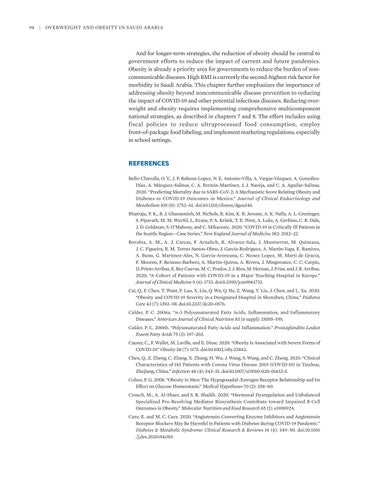94
|
Overweight and Obesity in Saudi Arabia
And for longer-term strategies, the reduction of obesity should be central to government efforts to reduce the impact of current and future pandemics. Obesity is already a priority area for governments to reduce the burden of noncommunicable diseases. High BMI is currently the second-highest risk factor for morbidity in Saudi Arabia. This chapter further emphasizes the importance of addressing obesity beyond noncommunicable disease prevention to reducing the impact of COVID-19 and other potential infectious diseases. Reducing overweight and obesity requires implementing comprehensive multicomponent national strategies, as described in chapters 7 and 8. The effort includes using fiscal policies to reduce ultraprocessed food consumption, employ front-of-package food labeling, and implement marketing regulations, especially in school settings.
REFERENCES Bello-Chavolla, O. Y., J. P. Bahena-Lopez, N. E. Antonio-Villa, A. Vargas-Vázquez, A. GonzálezDíaz, A. Márquez-Salinas, C. A. Fermín-Martínez, J. J. Naveja, and C. A. Aguilar-Salinas. 2020. “Predicting Mortality due to SARS-CoV-2: A Mechanistic Score Relating Obesity and Diabetes to COVID-19 Outcomes in Mexico.” Journal of Clinical Endocrinology and Metabolism 105 (8): 2752–61. doi:10.1210/clinem/dgaa346. Bhatraju, P. K., B. J. Ghassemieh, M. Nichols, R. Kim, K. R. Jerome, A. K. Nalla, A. L. Greninger, S. Pipavath, M. M. Wurfel, L. Evans, P. A. Kritek, T. E. West, A. Luks, A. Gerbino, C. R. Dale, J. D. Goldman, S. O’Mahony, and C. Mikacenic. 2020. “COVID-19 in Critically Ill Patients in the Seattle Region—Case Series.” New England Journal of Medicine 382: 2012–22. Borobia, A. M., A. J. Carcas, F. Arnalich, R. Alvarez-Sala, J. Montserrat, M. Quintana, J. C. Figueira, R. M. Torres Santos-Olmo, J. Garcia-Rodriguez, A. Martin-Vega, E. Ramirez, A. Buno, G. Martinez-Ales, N. Garcia-Arenzana, C. Nunez Lopez, M. Marti de Gracia, F. Moreno, F. Reinoso-Barbero, A. Martin-Quiros, A. Rivera, J. Mingorance, C. C. Carpio, D. Prieto Arribas, E. Rey Cuevas, M. C. Prados, J. J. Rios, M. Hernan, J. Frias, and J. R. Arribas. 2020. “A Cohort of Patients with COVID-19 in a Major Teaching Hospital in Europe.” Journal of Clinical Medicine 9 (6): 1733. doi:0.3390/jcm9061733. Cai, Q., F. Chen, T. Want, F. Luo, X. Liu, Q. Wu, Q. He, Z. Wang, Y. Liu, J. Chen, and L. Xu. 2020. “Obesity and COVID-19 Severity in a Designated Hospital in Shenzhen, China.” Diabetes Care 43 (7): 1392–98. doi:10.2337/dc20-0576. Calder, P. C. 2006a. “n-3 Polyunsaturated Fatty Acids, Inflammation, and Inflammatory Diseases.” American Journal of Clinical Nutrition 83 (6 suppl): 1505S–19S. Calder, P. C. 2006b. “Polyunsaturated Fatty Acids and Inflammation.” Prostaglandins Leukot Essent Fatty Acids 75 (3): 197–202. Caussy, C., F. Wallet, M. Laville, and E. Disse. 2020. “Obesity Is Associated with Severe Forms of COVID-19.” Obesity 28 (7): 1175. doi:10.1002/oby.22842. Chen, Q., Z. Zheng, C. Zhang, X. Zhang, H. Wu, J. Wang, S. Wang, and C. Zheng. 2020. “Clinical Characteristics of 145 Patients with Corona Virus Disease 2019 (COVID-19) in Taizhou, Zhejiang, China.” Infection 48 (4): 543–51. doi:10.1007/s15010-020-01432-5. Cohen, P. G. 2008. “Obesity in Men: The Hypogonadal–Estrogen Receptor Relationship and Its Effect on Glucose Homeostasis.” Medical Hypotheses 70 (2): 358–60. Crouch, M., A. Al-Shaer, and S. R. Shaikh. 2020. “Hormonal Dysregulation and Unbalanced Specialized Pro-Resolving Mediator Biosynthesis Contribute toward Impaired B Cell Outcomes in Obesity.” Molecular Nutrition and Food Research 65 (1): e1900924. Cure, E. and M. C. Cure. 2020. “Angiotensin-Converting Enzyme Inhibitors and Angiotensin Receptor Blockers May Be Harmful in Patients with Diabetes during COVID-19 Pandemic.” Diabetes & Metabolic Syndrome: Clinical Research & Reviews 14 (4): 349–50. doi:10.1016 /j.dsx.2020.04.019.






